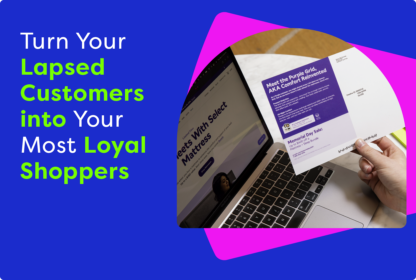When it comes to marketing programs, an adage still rings true today: garbage in = garbage out.
Said another way, your programs are only as good as the data that goes into them.
Without fresh, accurate data, you can’t get a complete picture of your target customer or prospect, their activity across the Internet, offline transactions, or recent behaviors that indicate current intent to buy your product or service.
Your brand likely possesses rich first-party data about customers and prospects, but this information is limited in scale because it’s primarily drawn from transaction data, which can quickly become stale if purchase activity is limited or old. In addition, you might not clearly understand their household–if the customer is connected to more than one address in your CRM. You may have also tried to use third-party data to fill in the gaps about your audience and get better reach. However, third-party data is often stale and inaccurate. That’s one reason third-party cookies are falling out of favor, and with good reason.
There is a better way to fuel your marketing programs and, in turn, drive better performance. Use better data.
Shared first-party data—where data from hundreds of brands is pooled together, anonymized, and then leveraged by participating brands to learn more about their target customers—can help you run more effective marketing campaigns. It lets you know the most accurate place to reach a consumer.
This approach combines billions of intent, transaction, and customer data points from hundreds of premium brands. It has a privacy-first design, so no brand can see what data belongs to another brand. Because the data is aggregated, it offers more significant benefits to brands sharing portions of their first-party data. Instead of garbage, you have a treasure trove to help guide your program to more robust results.
Precise Targeting and More
It’s one thing to hit the target. It’s another thing entirely to hit the bullseye. That’s why we constantly feed our shared first-party data asset, the PebblePost Graph, with the latest or additional signals to provide precision targeting. With the freshest data, you can get more precise with your targeting.
We continuously pull this data from billions of signals to produce the freshest information. This means greater recency, efficacy, and performance.
PebblePost does not just rely on online signals. We draw on online and offline signals and customer data, such as the nearly 100% U.S. household addresses we have as a stable and more persistent identifier. This combination of the three most predictive data types–intent, transaction, and customer–helps better determine behavior and boost confidence in targeting the right users through maximum reach and scale that your brand’s first-party data alone can’t provide.
Here are six ways that using shared first-party data from the PebblePost Graph improves your marketing performance.
- Improved Targeting and Relevance
Inaccurate data can lead to inaccurate targeting, sending marketing messages to irrelevant audiences. This results in wasted resources and lower campaign effectiveness. Marketers waste 21 cents of every media dollar because of poor data quality.
Truly accurate data, however, allows marketers to better understand customer demographics, preferences, and behaviors. This leads to more precise audience segmentation, ensuring you deliver marketing messages that resonate with your target. Relevance improves when data is accurate, enabling marketers to tailor messages based on specific customer needs or past interactions. This can lead to higher engagement, improved conversion rates, and more meaningful customer relationships.
It’s important to recognize that a part of targeting is suppression. If you can’t accurately target, you’re likely converting customers in prospecting campaigns, muddying the performance data.
- Enhanced Customer Experience
Bad data can result in misaligned messaging, such as sending promotions for products a customer has already purchased or irrelevant offers, damaging customer trust and leading to churn. Interestingly, one study found that 25% of businesses with over 500 employees lose at least one customer monthly due to incomplete or inaccurate information.
Accurate data can create a seamless and cohesive customer experience across multiple channels. When customer data is fresh and consistent, you can make recommendations, offer special deals, and more. Enhanced customer satisfaction and loyalty will be among the outcomes.
Consistent data across platforms ensures customer interactions align with their journey, preventing frustrating experiences like receiving irrelevant offers or duplicate messages.
- Optimized Marketing Spend and ROI
Less-than-accurate data can inflate marketing costs by targeting the wrong audience or continuing ineffective campaigns, reducing the overall efficiency of marketing investments. It was recently reported that 60% of enterprise decision-makers don’t know how much bad data costs them—about $12.9 million annually.
Data accuracy directly impacts marketing efforts’ return on investment (ROI). With precise data, marketers can focus their resources on high-value customers and profitable channels, reducing waste and maximizing the efficiency of marketing spend.
Accurate data helps identify the most effective strategies, leading to continuous improvement and higher ROI.
- Effective Attribution and Performance Measurement
Dirty data can lead to flawed attribution models, making assessing what truly drives conversions difficult. This, in turn, hampers efforts to optimize performance.
Accurate data enables marketers to track and measure the success of their campaigns across different touchpoints. This is essential for proper attribution modeling, where marketers can see which channels, messages, or interactions contributed most to conversions. Reliable data ensures you measure the right metrics, helping marketers optimize future campaigns and refine their strategies.
- Compliance and Reputation Management
Bad data can lead to non-compliance with data privacy regulations, resulting in legal fines, damaged brand reputation, and loss of customer trust. If you get a Federal Trade Commission Notice of Penalty Offenses that it believes has harmed consumers, your brand may face more than $50,000 per offense. It can add up quickly.
Accurate data is critical for complying with data privacy regulations and laws at the federal and state levels. By ensuring that customer data is current and correct, you can avoid legal penalties and ensure trust with consumers regarding data usage.
Brands that manage data accurately and transparently are more likely to build a positive brand reputation, as consumers are increasingly concerned about how brands use their data.
- Customer Retention and Loyalty
Poor data can lead to missed signals of customer dissatisfaction, resulting in higher churn rates and lower customer retention.
Accurate data allows for precise customer behavior and preferences monitoring, which is essential for creating retention and loyalty programs. Knowing when customers will likely churn allows you to take proactive steps to re-engage them.
By delivering personalized experiences based on accurate data, businesses can foster greater loyalty and increase customer lifetime value (CLV).
Use Better Data for Better Marketing
Ensuring you are using accurate, fresh data from online and offline sources is a straightforward way to realize immediate improvements in marketing performance. Not only will you be able to allocate your budget to the audience members most likely to convert, but you’ll also have the right intel to optimize your campaigns in real time.
If you want to know more about our shared first-party data asset, the PebblePost Graph, and how it can help improve the performance of your omnichannel marketing programs, let’s talk!



